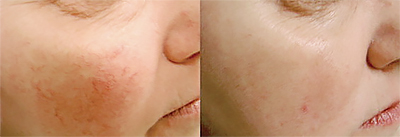Lasers and lights: How well do they treat rosacea?

Different treatments for different signs of rosacea
When dermatologists create a treatment plan for rosacea, the plan often consists of medication, a rosacea friendly skin care plan, and tips to help you avoid flare-ups. Sometimes, a treatment plan also includes a procedure, such as laser therapy.
Your treatment plan is most likely to include a laser or light therapy if rosacea has caused:
Visible blood vessels
Thickening skin
A laser or light treatment can reduce (or get rid of) the blood vessels. To remove thickening skin, dermatologists may use laser resurfacing.
Laser treatment can also reduce redness. In a few small studies, lasers were used to treat permanent redness on the face or the redness surrounding acne-like blemishes. Some patients saw a considerable reduction in redness. Most patients, however, had about a 20% reduction in redness.
Because different lasers and exposure times were used in these studies, more research is needed to know how well lasers can treat the redness.
If you have permanent redness on your face, your dermatologist may prescribe a medication. Approved by the U.S. Food and Drug Administration (FDA), this medication can reduce (or clear) the redness for up to 12 hours. After 12 hours, the redness tends to return.
Use sun protection
To prevent side effects after laser or light treatment, stay out of the sun and protect your skin when you must be outdoors.

What results are typical with laser or light therapy?
When used to treat visible blood vessels, most patients see a 50% to 75% reduction in visible blood vessels after 1 to 3 treatments. Some people see a 100% reduction.
Treatments are usually spaced 3 to 4 weeks apart.
If you have thickening skin, a skilled cosmetic dermatologist can give you very good results with in-office surgery and laser resurfacing. Patients who treat their thickening skin early tend to see the best results.
How long do results from lasers and lights last?
When used to treat blood vessels, the results tend to last 3 to 5 years. Treated blood vessels don’t reappear, but new ones can form.
Thickening skin tends to return after treatment. To prevent this and help you maintain results, your dermatologist can prescribe medication. You may also need follow-up laser therapy in the future.
What are the possible side effects from lasers and light treatments?
If you are considering a laser or light treatment, it’s important to know that your results depend largely on the person performing your treatment.
When you see a dermatologist, you’ll be in the care of a doctor who has the most experience treating the skin and skin diseases. Dermatologists:
Know the skin and treats rosacea often
Consider your medical history before creating a treatment plan
Can tell you whether laser therapy or light device can effectively treat your rosacea
If a laser or light treatment is right for you, you may have some temporary side effects after a dermatologist treats you. After treatment, it’s common to see some redness. This usually fades within 2 weeks.
You may also see a rash of purple or red spots. These, too, tend to clear in 1 to 2 weeks.
During treatment, some patients experience skin tightening, itch, or pain.
Scarring is rare in skilled hands.
To help you get the best results, you should receive instructions that explain how to care for your treated skin. Follow these instructions carefully.
While the instructions about sun protection may seem unnecessary, sun protection is really important. Staying out of the sun and protecting your skin from the sun’s rays help prevent permanent scars.
What to tell your dermatologist
To get the best results, communication is essential. If a laser or light treatment may be an option for you, it’s important for your dermatologist to know:
Which medications you take, including warfarin, isotretinoin, and aspirin
What other medical conditions you have, such as getting cold sores from time to time
If you are sensitive to light or bruise easily
What results you expect
Insurance warning
Although the FDA has approved some lasers and lights for treating rosacea and patients get good results, health insurance rarely covers the cost.

More research needed
Researchers continue to study how lasers and light treatments can treat rosacea. As we learn more, these devices may play a bigger role in treating rosacea.
If you’re interested in this treatment, a board-certified dermatologist can tell you whether a laser or light treatment may help treat your rosacea. You’ll know a dermatologist is board certified if you see the letters “FAAD” after the doctor’s name.
 Atopic dermatitis: More FDA-approved treatments
Atopic dermatitis: More FDA-approved treatments
 Biosimilars: 14 FAQs
Biosimilars: 14 FAQs
 How to trim your nails
How to trim your nails
 Relieve uncontrollably itchy skin
Relieve uncontrollably itchy skin
 Fade dark spots
Fade dark spots
 Untreatable razor bumps or acne?
Untreatable razor bumps or acne?
 Tattoo removal
Tattoo removal
 Scar treatment
Scar treatment
 Free materials to help raise skin cancer awareness
Free materials to help raise skin cancer awareness
 Dermatologist-approved lesson plans, activities you can use
Dermatologist-approved lesson plans, activities you can use
 Find a Dermatologist
Find a Dermatologist
 What is a dermatologist?
What is a dermatologist?